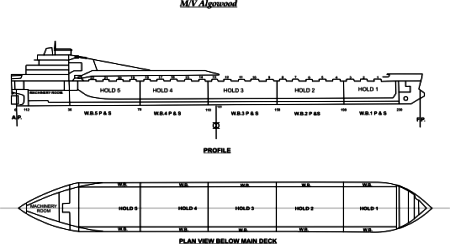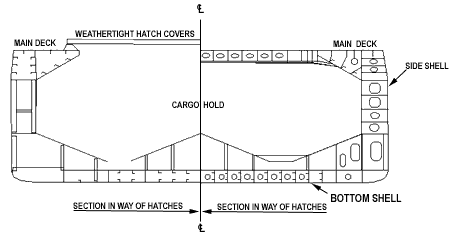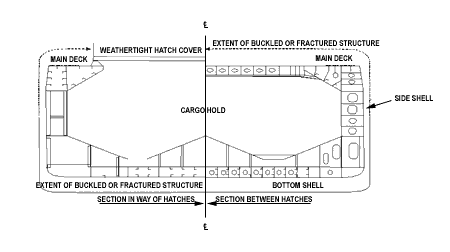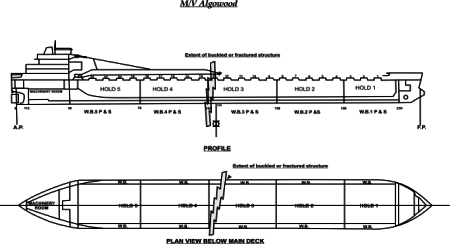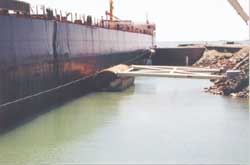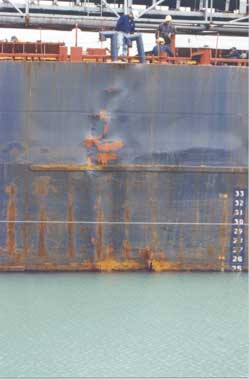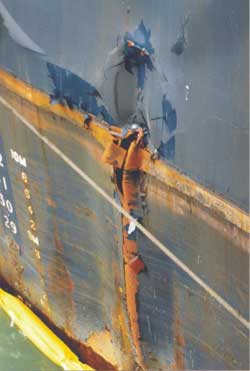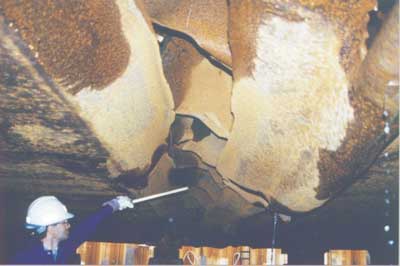Structural Failure
Bulk Carrier Algowood
Bruce Mines, Ontario
The Transportation Safety Board of Canada (TSB) investigated this occurrence for the purpose of advancing transportation safety. It is not the function of the Board to assign fault or determine civil or criminal liability. This report is not created for use in the context of legal, disciplinary or other proceedings. See Ownership and use of content. Masculine pronouns and position titles may be used to signify all genders to comply with the Canadian Transportation Accident Investigation and Safety Board Act (S.C. 1989, c. 3).
Summary
At about 2345 local time, 01 June 2000, while loading a cargo of aggregates at Bruce Mines, Ontario, the hull of the Canadian bulk carrier Algowood buckled in way of hold No 3. The vessel flooded, sat on the bottom alongside the dock, and was later salvaged and towed to dry dock for repairs.
1.0 Factual Information
1.1 Particulars of the Vessel
| Name | "Algowood" |
|---|---|
| Port of Registry | Sault Ste. Marie, Ontario |
| Flag | Canada |
| Official Number | 372055 |
| Type | Great Lakes bulk carrier, self-unloader |
| Gross TonnageFootnote 1 | 22 558.32 |
| Length Over All | 222.5 metres |
| Breadth | 23.13 metres |
| Depth | 14.17 metres |
| Classification Society | Lloyd's Register of Shipping |
| Classification of Voyage | Inland Voyage, Class II |
| Built | 1981, Canadian Shipbuilding & Engineering Ltd., Collingwood, Ontario |
| Propulsion | 2 MAK Diesels, Model 6M552 7600 kw, single screw controllable pitch propeller |
| Owner and Technical Manager | Algoma Central Corporation (Algoma Central Marine) |
1.1.2 Description of the Vessel
The Algowood is a self-unloading bulk carrier of all-welded steel construction, with five cargo holds. The propelling machinery, steering gear, wheelhouse, life-saving equipment, and all crew accommodation are located at the after end of the vessel. The location of cargo holds and water ballast tanks are shown in Figure 1. The hull is subdivided by transverse watertight bulkheads: a collision bulkhead, a bulkhead at the after end of the cargo space, and a bulkhead at the after end of the engine room.
To unload the vessel, gates at the bottom of the five hopper-shaped holds are opened. This allows cargo to fall onto two fore-and-aft conveyor belts which transport the cargo to the transfer-and-loop belt system at the after end of the cargo space. It is then raised by the loop belt system to an above-deck unloading boom for discharge over the side. The area where the belts run under the cargo holds and the space at the after end which houses the loop belt are referred to as the "tunnel" and the "loop belt casing", respectively.
1.1.3 Certification of the Vessel
The Algowood was inspected by Transport Canada Marine Safety (TCMS) ship surveyors on 27 March 2000 in Hamilton, Ontario. A ship inspection certificate (SIC 11) was issued on 27 March 2000, valid until 26 March 2001. The ship was also issued with a Load Line Certificate, Great Lakes and Inland Waters of Canada, valid until 31 March 2002.
1.2 History of Events
The Algowood arrived at Bruce Mines, Ontario, at 1755 eastern daylight time on 01 June 2000 and commenced loading aggregates and manufactured sand at 1813, in accordance with an intended loading/deballasting plan. Except for times required for shifting the vessel in way of the loading structure and brief equipment maintenance periods, loading continued until 2345 the same day.
On its arrival at Bruce Mines, the vessel was in a ballast condition, with all cargo holds empty. Port ballast tank No 3 was pumped for nine minutes as a counter balance to the vessel's unloading boom, the discharge end of which was slowly moving out over the starboard side of the vessel to allow loading into No 5 cargo hold. The deck officer (first mate) in charge (OIC), responsible for deballasting and loading, indicated that the forepeak ballast tank had been previously pumped out to a sounding of approximately 12 inches. Port and starboard (P & S) No 5 ballast tanks, which were not fully pressed up, were being pumped as of 1805. At 1813, the vessel was ready to load into cargo hold No 5, hatches nos 21, 19, and 20, respectively. Loading started at 1823.
As of 1843, P & S ballast tanks No 4 were being discharged. At 2035, loading of cargo in hold No 5 was completed with 5700 tons of sand (table in section 1.4). The draught aft was reported to be 6.553 metres (21 feet 6 inches). As of 1952, pumping of No 3 P & S ballast tanks recommenced and was suspended at 2010. At 2032, No 3 P & S ballast tanks were pumped again, this time to completion at 2145.
According to the loading plan, the after draught of the vessel was near the maximum allowable of 6.858 metres (22 feet 6 inches). At this time, the OIC deviated from the loading sequence and directed the shore rig loader to load HL1 aggregates into hatch No 9 instead of hatch No 13. The shore rig loader, who was provided with a copy of the intended loading plan for clarification, questioned and acknowledged the sudden change to the loading plan. Loading into hatch No 9 commenced at 2044. Pumping of No 2 and No 1 P & S ballast tanks started at 2111 and 2130 respectively. By 2126, 1756 tons of cargo had been loaded into cargo hold No 3. Starboard ballast tank No 3 was completely pumped out between 2032 and 2145.
At this time, the vessel had reached the maximum draught aft and shifting of the vessel aft began. The vessel came to a sudden and abrupt stop, indicating that after end of the vessel might have touched bottom near the end of the slip. The loading rig was just able to reach into hatch No 2 of cargo hold No 1, in which loading commenced at 2132. While loading hatch No 2, the vessel trimmedFootnote 2 forward and the draught aft was reduced. The OIC shifted the vessel further aft so that the loading rig could begin loading into hatch No 1. At approximately 2145, the master returned to the ship and inquired briefly about the vessel's condition of loading with the OIC, after which he proceeded to his cabin.
At 2202, pumping of P & S ballast tanks Nos 1 and 2 was stopped. Ballast tanks No 1 P & S were pumped again from 2240 to 2242. Pumping of No 2 P & S ballast tanks resumed at 2242 and finished at 2315.
Reading draughts in the dark was difficult at this time because visibility was further reduced in rain showers. The after draught was 6.477 metres (21 feet 3 inches) at this time and was decreasing as loading forward continued. At 2242, pumping of P & S ballast tanks No 2 resumed. The loading of cargo hold No 1 was almost completed, with an additional 1800 tons loaded through hatches nos 1, 2, and 3 at 2322. Draughts at this point were 6.096 metres (20 feet) aft, 4.801 metres (15 feet 9 inches) at midship, and 3.962 metres (13 feet) forward; according to the OIC, the vessel was hoggedFootnote 3 by approximately 0.229 metre (9 inches). The rig operator indicated that there would be a shut down for minor repairs. At 2315, P & S ballast tanks No 2 were pumped out.
At 2345, while continuing to load into hatch No 3 of cargo hold No 1, the ship made a very loud wrenching sound and buckledFootnote 4 between hatches nos 13 and 14, in way of the transverse bulkhead, between frames 117 and 119. Loading was stopped and the general alarm sounded.
At 0010, all crew members were evacuated to shore with the exception of the master and the chief engineer. An initial survey revealed no major pollution. However, an oil boom was deployed to contain some minor hydraulic oil leaks.
The forefootFootnote 5 and stern section of the vessel struck the ground; subsequently, the hull settled on the bottom. All cargo holds of the vessel were progressively flooded through the tunnel. Concurrent damage to the ballast suction piping led to flooding of the water ballast tanks forward of the structural damage. As flooding progressed, the vessel settled on the bottom with the hull immersed at 8.2 metres (26 feet 11 inches) forward and 8.1 metres (26 feet 7 inches) aft. Flooding extended from the collision bulkhead to the forward bulkhead of the engine room.
In the days following the occurrence, salvage operations were monitored by Lloyd's Register of Shipping, the Salvage Association, and TCMS. Temporary repairs included substantial steel bracing welded to the outside of the shell plating spanning the hull damage. Cargo was unloaded from the holds and diesel oil was discharged. On 10 July 2000, the vessel was towed to the dry docks at Port Weller, Ontario, for a detailed damage survey, repairs, and reconstruction.
1.3 Certification of Personnel
The master and officers held certificates valid for their positions and for the trade in which the vessel was engaged. The master held a certificate for master, local voyage, issued in 1979. The first mate held a certificate for master, local voyage, issued in 1999. The most recent continued proficiency endorsement for both individuals was acquired in 1999.
1.4 Loading Summary
The following table includes the best estimates of cargo quantities loaded into each hold at the time of the occurrence. Quantities are rounded to the nearest ton.
| Hold Number | Cargo | Tons (as per Bruce Mines records) |
Tons (as per Algoma records) |
|---|---|---|---|
| 1 | Aggregates (HL1) | 4923 | 5200 |
| 2 | Empty | ||
| 3 | Aggregates (HL1) | 1567 | 1750 |
| 4 | Empty | ||
| 5 | Sand | 5744 | 5700 |
| Total | 12 234 | 12 650 |
Water ballast on board the vessel on 01 June 2000, at the time of the occurrence, totalled approximately 31.8 tons. All ballast tanks were sequentially pumped, leaving 11.8 tons in the forepeak and 20 tons in the afterpeak.
1.5 Condition of the Bottom Alongside the Berth
Once the Algowood was removed from the loading berth, an underwater survey of Bruce Mines harbour found that there was no obstruction along the line of dolphins used for berthing. The maximum after draught allowable was 6.858 metres (22 feet 6 inches) because of the lake's low water level at that time and the presence of a shallow area in the approach channel.
1.6 Injuries to Persons
No one was injured.
1.7 Damage Surveys at Bruce Mines
The Algowood experienced a sudden, major structural hull failure, the location, nature, and extent of which are shown in figures 3 and 4 and photographs 1, 2, and 3. Damage surveys, carried out when the vessel was alongside at Bruce Mines, revealed extensive buckling and distortion on the deck (Figure 4) above waterline P & S shell plating with localised buckling and tensile fracturing of the side shell and of the P & S ballast tank hopperFootnote 6 side.
1.8 Damage Survey in Dry Dock
Inspection while in dry dock revealed structural buckling and extensive fracturing from the turn of the bilgeFootnote 7 to the bottom shellFootnote 8, P & S, inner bottom, and P & S ballast tank hopper side plating in way of the transverse bulkhead between frames 117 and 119, between holds no 3 and 4 (Photograph 2). The inspection in dry dock also revealed other deformations, distortions, and localised fractures in the forward and after sections of the bottom shell plating. These were caused by the vessel contacting and settling on the bottom during the occurrence.
1.9 Shell Plating Thickness Gauging, Laboratory Testing, and Hull Stresses
On 18 July 2000, while the vessel was in dry dock for a damage survey and before the start of permanent repairs, material thickness was gauged ultrasonically by the TSB and shipyard personnel to determine the current thicknesses of principal structural members in the frame spaces immediately forward and abaft the major hull failure. This survey included measurements taken in a band around the vessel in way of frames 117 to 119.
Gauge readings at each of these locations generally showed wastage of 1 to 7 per cent in the shell, bilge, keel, and bottom structural members. There was a mean thickness reduction of some 13 per cent in way of the tank top plating. None of the recorded material thickness wastage readings exceeded accepted limits at which replacement of the material would be required.
During this survey, steel sample specimens were cut out from the keel plate, bottom shell, turn-of-bilge plating, and tank top adjacent to the hull failure, and forwarded to the TSB Engineering Laboratory to identify and determine the current chemical and mechanical characteristics of the steel used in construction of the Algowood.
Laboratory examination identified the material as steel, having no abnormalities to adversely affect weldability and having tensile properties and notch-toughnessFootnote 9 characteristics comparable to those of Lloyd's Grade A steel.
Post-occurrence calculations of the still water bending momentFootnote 10, Footnote 11 (SWBM), imposed on the Algowood when partially loaded at Bruce Mines, were made to determine the magnitude and nature of bending stressesFootnote 12 incurred by the steel structure in way of the hull failure.
These calculations confirmed that, immediately before hull failure, the vessel was subjected to a hogging/bending moment about 2.3 times the maximum permissible (sea going). A hogging/ bending moment puts the main deck plating in tension and the bottom structure in compression. The hogging condition, induced at the time of the occurrence, was due to the excess of weight over buoyant support at the ends of the vessel.
1.10 Vessel Strength and Stability
The Algowood complied with regulatory requirements and the classification society's structural and longitudinal strength requirements. The Trim and Stability Book with Loading Calculations was approved by TCMS and Lloyd's Register of Shipping. The booklet included information for the master's guidance on the amount of cargo to be loaded into each hold to obtain a desired draught with acceptable shear forces and bending moments for each loading condition. This booklet contains 20 representative loading conditions but does not outline loading and deballasting sequences. The Lloyd's Register of Shipping approved copy was on board at the time of the occurrence.
The Algowood was subject to the requirements of the Load Line Regulations (Inland), which state that the master of every ship shall be supplied with sufficient information, in an approved form, to enable him to arrange for the loading and ballasting of his ship in such a way as to avoid the creation of unacceptable stresses in the ship's structure.
1.11 Loading Sequence
The ship's personnel generally supervised loading operations in accordance with the routines established by experience on this and other Great Lakes bulk carriers. Adopted cargo loading and unloading sequences depend on the configuration of different ports and their discharge facilities. The sequence also varies with the type and deadweight of each cargo. This plan is prepared before arrival at the loading ports and indicates the vessel's draughts, hatch numbers, cargo, weight, and instructions regarding ballast pumping sequence.
In this instance, the loading plan, prepared by the OIC using a personal computer not programmed as a loading instrument, was approved by the master and was also to be used in coordination with the terminal operators.
Loading plan:
Drafts: FWD: 25′06″, MID: 25′06″, AFT: 25′06″
Trip# 0016
Date: June 01, 2000
Cargo: Aggregates
| HOLD | NO. 5 | NO. 4 | NO. 3 | NO. 2 | NO. 1 |
|---|---|---|---|---|---|
| PORT | BRUCE MINES | MELDRUM BAY | BRUCE MINES | MELDRUM BAY | BRUCE MINES |
| CARGO | SAND | HL1 | HL1 | ||
| TONS | 5700 T | 7200 T | 3500 T | 5600 T | 5800 T |
TOTAL TONNAGE (APPROXIMATELY): 27 900 T
| HATCH | HOLD | CARGO | TONS | REMARKS (BRUCE MINES) |
|---|---|---|---|---|
| 21 | 5 | SAND | 4000 | Pump out #3 PORT and BOOM OUT. |
| 19 | 5 | SAND | 1200 | Pump out #5 tks./Pump out #4 tks. |
| 20 | 5 | SAND | 500 | |
| F 13′09″ A 21′04″ Approx. | ||||
| 13 | 3 | HL1 | 1750 | Pump out #3 STBD and BOOM IN to centre. |
| 09 | 3 | HL1 | 1750 | Pump out #3 tks P & S when boom in centre. |
| F 14′00″; A 21′06″; Approx. | ||||
| 02 | 1 | HL1 | 4400 | Pump out #2 tks./ Pump out #1 tks. |
| 01 | 1 | HL1 | 500 | Strip F/Pk if needed. Ensure A/Pk out. |
| 03 | 1 | HL1 | 900 | |
| F 15′06″A 19′08″ Approx. | ||||
| MELDRUM BAY | ||||
| 06 | 2 | 4000 | Raise boom to maximum height. | |
| 04 | 2 | 900 | ||
| F 23′09″A 17′00″ | ||||
| 16 | 4 | 4000 | ||
| 14 | 4 | 1200 | ||
| 18T | 4 | (2000) | TRIM TO AFT DRAFT. | |
| 08 | 2 | (700) | TRIM TO FWD DRAFT. |
The cargo loading and deballasting sequences were not carried out according to the agreed upon plan. This is due in part to the fact that, at a point in the loading, the vessel could not be moved further astern in the limited depth of water available near the northern extremity of the slip until the aft draught was decreased. Verbal communication was used to enable the OIC to confirm and validate the actual pumping performed by engine room staff. Ballast tank water levels would be confirmed later by tank soundings from deck level. Because a record of tank soundings while deballasting was not kept in the deck log book, it was difficult to coordinate pumping of tanks. It was not possible to confirm the sequence for deballasting, especially when deviations to the plan took place.
1.12 Cargo Watch Schedules
The second mate and first mate stood their normal 1200 to 1600 and 1600 to 2000 watches, respectively. Between watches, each had eight hours off, which included several hours of rest. Consequently, fatigue is not considered to have been a contributing factor in this occurrence.
1.13 Previous Safety Recommendations Regarding Bulk Carriers
During the course of an investigation concerning damage to the S.S. Beechglen, (TSB Report M91C2007), the TSB issued recommendation M94-17 with respect to industry operational practices and to loading/unloading procedures:
The Department of Transport require that masters on all Canadian bulk carriers be provided with comprehensive written loading and unloading guidance, including the maintenance of a "Cargo Book", to ensure that maximum allowable hull girder stresses are not exceeded.
Transport Canada (TC) accepted the recommendation. In response to it and associated correspondence, TC advised that the Canadian Code of Safe Practice for Solid Bulk Cargoes (TP 5761) would be revised to reflect the latest International Maritime Organization (IMO) requirements. On 17 July 1995, Ship Safety Bulletin (SSB) NO 13/95 was issued by TC, warning that improper practices and procedures during cargo handling operations was a major cause of extensive structural overstressing damage. A copy of IMO circular MSC 690 was attached to the bulletin. On 26 October 1998, SSB 13/98 was issued, which included the Code of Practice for the Safe Loading and Unloading of Bulk Carriers. Further attention was drawn to the new International Convention for the Safety of Life at Sea (SOLAS) chapter VI amendments on carriage of cargoes, in particular Regulation 7 that came into force internationally on 01 July 1998. The regulation requires ships to be provided with a booklet that specifies maximum permissible forces and moments on the ship's hull during loading, unloading, and the voyage.
TCMS has also published SSB 07/1996 and 15/1999 to give wide distribution to the issue of bulk carrier safety. It was recommended that all parties involved in loading and unloading bulk cargoes take the Code of Practice for the Safe Loading and Unloading of Bulk Carriers into consideration, become fully familiar with and include the use of these procedures in their operations.
Following the damage to the S.S. Beechglen, the owners revised their procedure manuals to require ships' crews to monitor ballasting and deballasting during all loading and unloading operations and to record such operations in a permanent record book, kept in both the engine room and on the bridge. In addition, at the change of watch, the officer being relieved is required to instruct the relieving officer as to the state of the ballast tanks.
In a TSB report on the break up and sinking of the bulk carrier Flare (TSB Report M98N0001), the Board was concerned that mariners may not fully appreciate that deviation from approved loading manuals may overstress the structure and lead to catastrophic failures. The Board recommended that:
The Department of Transport, in coordination with international agencies (including the International Maritime Organization and the International Association of Classification Societies), bring the need for stricter adherence to approved loading manuals to the attention of shipowners, ship operators and ship masters in order to avoid undue structural stresses in bulk carriers.
Transport Canada accepted the recommendation. In response, TC advised that the matter will be brought to the attention of future Port State Control (PSC) meetings to ensure that signing member states to the Paris and Tokyo memoranda of understanding on PSC are aware of and understand the importance of ensuring compliance during PSC inspections. TC has also advised that the matter has been brought to the attention of IMO and TCMS will continue its participation in Working Groups on Bulk Carrier Safety at IMO. The Dangerous Goods, Solid Cargoes & Containers (DSC) Subcommittee is developing a manual on Loading and Unloading of Solid Bulk Cargoes for Terminal Representatives.
1.14 Loading Plan and Operating Procedures
At the time of the occurrence, the Trim and Stability Book with Loading Calculations, including longitudinal strength data such as SWBM, was aboard for the guidance of ship personnel. This copy was approved by Lloyd's on 22 February 1982 and contains 20 representative loading conditions. The Notes for the Master state that "this book is for information and that it must be considered as such at all times".
It is general practice for the first mate to prepare a loading plan and present it to the master for approval. Details and calculations for the loading plan are based on the knowledge and experience of both first mate and master, combined with past loading/unloading data for the vessel.
The first mate had the option of using either a form prepared by the Marine Division of Algoma Central Railway (Form 226, Vessel Loading Plan) or a computer spreadsheet using the vessel's onboard computer. Both methods ask for a description of the vessel, cargo weight and location, draughts and ballast, and loading time. However, neither includes information or makes calculations of the hull girder longitudinal strength, shear forces, and bending moments relative to the maximum SWBM approved by Lloyd's.
Post-occurrence calculations of the SWBM imposed on the Algowood, when loaded according to the intended loading plan, were made to determine the magnitude and nature of the related bending stresses. These calculations indicate that the vessel would have been subjected to a hogging/bending moment about 1.9 times the maximum permissible bending moment approved by Lloyd's. Adoption of similar loading cargo distribution in previous voyages would lead to fatigue in the hull structure.
Canadian regulations do not currently require that vessels of this class carry written guidance on cargo loading or unloading sequences. The company's Safety Management System Manual, which was on board the vessel at the time of the occurrence, contains a section entitled "Cargo Procedures". The manual refers to loading and unloading sequences, responsibilities, preparations for loading, loading, deballasting, preparations for unloading, unloading, ballasting, special precautions, and draught survey procedures.
Longitudinal stresses and loading procedures are addressed as follows:
- In preparing the load plan, the following must be taken into consideration: ...minimizing bulkhead, tank top, and longitudinal stresses during loading and deballasting processes.
- The cargo stowage in each compartment must be monitored frequently to ensure even distribution, having due regard for the avoidance of excessive list, load on the tank tops, and load against bulkheads.
2.0 Analysis
2.1 General Communications
In this occurrence, a telephone communication between the officer in charge (OIC) of loading/deballasting and the engine room staff was not formally reiterated. There is a time interval between the commencement of pumping ballast and the time when a watchman takes a water level reading from a respective tank. If there are 10 - 14 ballast tanks to be read, it is possible that it may be some time before a tank pumping sequence error is detected and the OIC is informed.
A formal, handwritten instruction may be the surest method for ensuring that a critical operation is carried out; on many ships, this is standard procedure for ballasting operations. In the case of a telephone instruction, if that instruction is repeated by the receiving party, the person issuing the order knows immediately if the order has been understood and can expect that it will be acted upon. Further, when the person carrying out the action confirms that it has been done, a second confirmation of the original order is completed.
2.2 Communications and Coordination - Loading/Deballasting
While loading was in progress, verbal instructions given to engine room staff to deballast were acknowledged, recorded, and carried out, but there was no corroboration from the engine room when the tanks had been emptied or pumped down. Most of the communication was one-way, from the deck to the engine room, with very little feedback. This lack of follow-up meant that the OIC ordering the deballasting of the vessel could only keep current of the vessel condition by noting physical tank soundings some time later, after pumping had commenced.
The result was that the vessel was subjected to bending moments that were markedly higher than the maximum permissible. This situation could have been avoided if more formal communications had been used and the agreed deballasting/loading plan was adhered to.
When the master returned to the vessel, some two hours prior to the occurrence, deviation from the loading plan and pumping sequence caused him some concern, but he indicated that he had faith in his officer's abilities. However, had the vessel's loaded condition been reassessed at that time, and appropriate corrective action been taken, the occurrence may have been prevented.
2.3 Loading and Deballasting
To minimize structural stress, cargo should be loaded and a similar weight of appropriately located water ballast discharged concurrently, (this is not always possible, given the rate at which bulk cargoes are loaded) and particular attention must be paid to the sequence of loading and deballasting.
Shortly before the hull failure, the loading was almost completed in hold No 1 and it contained approximately 4923 tons of cargo. Port and starboard (P & S) ballast tanks No 2 were nearly empty and there was no cargo in hold No 2.
The total weight and distribution of cargo, in conjunction with no loading in way of cargo hold No 2, contributed significantly to a bending moment on the hull girder of approximately 2.3 times the maximum permissible.
At 2035, loading of cargo into hatch nos 19, 20, and 21 was completed. The OIC deviated for the first time from the planned loading sequence and directed the shore rig to load HL1 aggregates into hatch No 9 instead of hatch No 13. This initial departure from the intended loading/ deballasting sequence led to complications and called for further deviations which eventually caused stresses that the hull could not withstand.
Deviations from the loading sequence, combined with a lack of appropriate compensatory ballasting measures to minimize hull stresses, caused the vessel to hog. The mechanical failure of the bottom structure occurred when compressive stress exceeded the critical buckling stress of the bottom structure. This caused extensive buckling and tensile fracturing of the adjacent structure, which culminated in the loss of longitudinal hull integrity.
2.4 Determination of Draughts
Factors affecting an accurate reading of the vessel's draught marks during loading were as follows: cold weather, poor lighting, driving rain, darkness, and a flashlight with reportedly insufficient candle power. The distance from the shoreline, where the draught was read, to the ship side markings at the stern was over 30 metres. At the bow, this distance was approximately 25 metres.
Because of changes in the accepted loading plan, close and frequent monitoring of draught marks forward, midship, and aft was necessary. For the majority of the loading period, weather was not a factor. As the weather deteriorated, the distance from the shore and the type of flashlight available made draught monitoring difficult; consequently, accurate readings were not obtainable.
Although the OIC of loading/deballasting believed that the vessel was hogged nine inches at the time of the occurrence, subsequent calculations indicate that the actual hog was significantly greater. Because of the difficulty of reading draught marks in prevailing conditions, the rate at which the cargo was loaded and the frequency of reading the draughts, the extent of deflection was not determined before the hull girder was overstressed.
2.5 Condition of the Bottom Alongside the Berth
The possibility that the vessel could have suffered localised distortions and fractures due to obstructions on the harbour bottom alongside the berth was examined. A hydrographic survey of the area was last conducted in September 1997. On 10 July 2000, divers conducted a localised survey to assess the depth and condition of the bottom. The survey found no features to indicate uncharted obstructions, boulders, or other features that could have caused bottom shell damage and contributed to the initiation of the hull failure. Furthermore, review of the mining company's ship loading record before June 2000 indicated that vessels had loaded at the berth to a departure draught deeper than that of the Algowood, and there were no reports of these ships having suffered damage as a result.
2.6 Officers' Knowledge of Structural Stresses
In 1998, Transport Canada Marine Safety (TCMS) published The Examination and Certification of Seafarers (TP2293). These standards are intended as a guide for the certification of officers on ships, reflecting the requirements of the Marine Certification and Crewing Regulations. Examination requirements of these standards, for a master local voyage, address requirements for ship construction and engineering, including the following:
Structures and Construction Methods
Knowledge of structural stresses; difference between stress and strain; sheer force and bending moments and interpretation of graphical solutions;...reasons for extra strengthening;...special construction features of VLCCs [very large crude carrier] and special methods employed to ensure adequate longitudinal and transverse strength; special construction features of oil/bulk/ore carriers.Footnote 13
Stresses in Ships
Knowledge of predominant stresses when unloading bulk carriers with grabs and by uneven off-loading; predominant stresses on bulk carriers when loading concentrates or other bulk products at a high rate; uneven distribution of cargo; heavy weights on deck or tank tops; stresses on hull caused by motion of a vessel at sea, including panting, pounding, hogging, sagging and racking; structural stresses when grounded.
The master and first mate held valid certificates for their positions and had passed examinations for each of the required subjects for that class of voyage, including the examination for ship construction and engineering.
Post-occurrence calculations, based on the intended loading plan, indicate the vessel would have been subjected to a SWBM 1.9 times that of the maximum approved level. In the absence of any prior calculations to determine the relative SWBM for the intended loading condition, neither the ship nor the company operating personnel were aware of its magnitude.
2.7 Existing Safety Measures for Bulk Carriers
Canada's bulk carrier fleet comprises some 70 vessels, which have an average age of over 33 years. Because of their particular service, bulk carriers operating exclusively on the Great Lakes are not required to conform to the more stringent requirements for ocean-going vessels and have especially reduced structural, scantling, and load line standards. However, basic principles of hull bending stress distribution are still applicable and, because of a bulk carriers' greater length-to-beam proportions, special attention is required during loading and unloading operations to ensure that excessively high stressing does not occur.
A review of structural failures history in Canada suggests that the probability of a catastrophic failure is minimal, but the consequences on people, property, and environment are considerable. Therefore, this small probability presents an undesirable risk which can be easily managed, using proven cargo loading practices to keep deck/bottom stresses within acceptable limits.
The International Maritime Organization (IMO), recognizing a need to improve the safe loading and unloading of bulk carriers engaged on international voyages, has amended the International Convention for the Safety of Life at Sea (SOLAS) by adding safety measures for bulk carriers. In particular, Chapter XII, Regulation 11 of SOLAS, addresses the loading of bulk carriers at least 150 metres long. This regulation requires that bulk carriers be fitted with loading instruments capable of providing information on hull girder shear forces and bending moments. It is recognised that the loading instrument is a necessary tool to more efficiently ensure that hull girder shear forces and bending moments are kept within permissible limits during, and at the conclusion of, loading or discharging operations. Although a loading instrument is not a regulatory requirement aboard Great Lakes bulk carriers, TCMS encourages the installation of such instruments.
The IMO has also adopted the Code of Practice for the Safe Loading and Unloading of Bulk Carriers to assist masters and officers in ensuring a safe operating environment.
3.0 Findings
3.1 Findings as to causes and contributing factors
- The intended loading and deballasting sequence was not adhered to and the vessel was subjected to excessive bending stress which resulted in structural failure of the hull. The disposition of the cargo and ballast at the time of the failure caused a still water bending moment about 2.3 times the maximum permissible.
- A lack of feedback communication, after deballasting instructions had been given, resulted in the OIC not being kept current with the progress of deballasting.
- The frequency and accuracy with which the draught marks were read during loading were insufficient to closely monitor the hogging of the hull. Draught mark readings became estimates as the weather deteriorated and not all means available to assist in accurately reading draughts were utilized.
- The magnitude of the stresses imposed on the Algowood, as a result of deviating from the intended loading sequence, were not known nor appreciated by shipboard personnel.
3.2 Findings as to risk
- Neither the ship nor company operational personnel were aware that the stresses that would have been imposed on the vessel by the intended loading plan, were 1.9 times the maximum permissible SWBM approved by Lloyd's.
3.3 Other Findings
- Laboratory examination determined that samples of steel taken from the area of structural failure had no abnormalities which adversely affected weldability and had tensile properties and notch-toughness characteristics comparable to those of Lloyd's Grade A steel.
- None of the recorded material thickness wastage readings exceeded accepted limits at which replacement of the material would have been required.
- A post-occurrence survey of the bottom alongside the berth confirmed that there were no uncharted obstructions, boulders, or other features that could have contributed to the initiation of the hull failure.
- The ship's approved loading manual on board the vessel contains representative loading conditions but does not outline loading and deballasting sequences.
4.0 Safety Action
4.1 Action Taken
As a result of this occurrence, Algoma Central Marine has initiated a review of its practices and procedures and has taken the following actions:
- Immediately following the incident, the company modified its cargo handling policy to put in place procedures that require all split loading and unloading to be reviewed by the company's naval architects to determine if the proposed load/unload falls within the allowable limits set for various vessels with respect to stress and shear forces.
- A training course was developed by the company's naval architects, addressing stresses and strains that occur on vessels during cargo handling operations. This seminar was presented to all masters and chief officers in the winter of 2000. A copy of this information was given to all participants and copies were sent to all vessels for junior officers to review.
- The company was investigating requirements for Stress and Stability Computers (loading instruments) prior to the incident in Bruce Mines. Subsequent to the incident, the company has contracted with a firm to develop and install loading computers in its fleet. Installation of these systems started in the fall of 2001 and should be completed by the summer of 2003.
- A review of past cargo handling practices was carried out on a sample of the company's fleet to determine if practices similar to those that took place on the Algowood were occurring on other Algoma ships. This review found no significant occurrences where a vessel's allowable SWBM had been exceeded.
- The company contracted with a marine consultant to perform an audit on company cargo handling procedures. Results of this audit were reviewed with management and led to development of the training program outlined above.
- A condition survey was carried out on all company vessels to determine if any structural deficiencies are occurring in the area where the Algowood failed. These surveys found no evidence of structural deficiencies in any of the vessels.
4.2 Safety Action Required
Loading information
Because of their particular service, bulk carriers operating exclusively on the Great Lakes are not required to conform to the more stringent requirements for ocean-going vessels and have especially reduced structural, scantling, and load line standards. However, basic principles of hull bending stress distribution are still applicable and, because of bulk carriers' greater length-to-beam proportions, special attention is required during loading and unloading operations to ensure that excessively high stressing does not occur.
The Canadian Load Line Regulations (Inland) require that the master of every ship shall be supplied with sufficient information, in an approved form, to enable him to arrange for the loading and ballasting of his ship in such a way as to avoid the creation of unacceptable stresses in the ship's structure.
Loading manuals onboard Canadian vessels provide masters with guidelines to assist them in ensuring that their vessels are safely ballasted and trimmed throughout a voyage, to maintain adequate structural integrity in port and in various operating conditions. The Algowood approved vessel's Loading Manual made reference to acceptable shear forces and bending moments for various loading conditions. However, these manuals do not address the vessel's loading sequence which, in this occurrence, led to complications which eventually caused stresses that the hull could not withstand.
It is possible, by improper distribution of loading, to highly stress the structure locally (under the load) and/or the basic longitudinal hull girder. Since the structural arrangements may vary greatly, the limitations associated with setting out exact rules for the distribution of loading in all ships have been recognized by International Maritime Organization (IMO). Toward this end, IMOFootnote 14 requires that bulk carriers engaged on international voyages be fitted with loading instruments capable of providing information on hull girder shear forces and bending moments. This provides the master with accurate and timely information on hull girder shear forces and bending moments to assist in preventing overstressing of the ship's structure.
Although the Algowood was in class and had passed all regulatory inspections, the Board is concerned that Canada's ageing bulk carrier fleet of some 70 registered ships, is vulnerable to structural failures with serious consequences. The Board is concerned that mariners may not fully appreciate that deviation from approved loading manuals and loading plans may overstress the structure and lead to catastrophic failures, in particular, the adverse consequences on the hull caused by the disposition of the cargo and ballast during loading operations. Overstressing of the hull may not be immediately evident during loading/discharging and could become manifested after the vessel leaves port and is at sea. Such failures could result in the loss of the vessel, cause extensive pollution, and also put the crew at serious risk, depending upon the circumstances at the time.
The Board believes that comprehensive loading and unloading information will help masters to arrange the loading and unloading so as not to overstress the structure. Therefore, the Board recommends that:
The Department of Transport require that masters on all Canadian bulk carriers of 150 m in length and over have continuous access to on-board or company shore-based hull stress monitoring systems to help ensure that maximum allowable hull girder stresses are not exceeded.
This report concludes the Transportation Safety Board's investigation into this occurrence. Consequently, the Board authorized the release of this report on .
5.0 Appendices
Appendix A - Glossary
- IMO
- International Maritime Organization
- OIC
- officer in charge
- P & S
- port and starboard
- PSC
- Port State Control
- SIC
- ship inspection certificate
- SOLAS
- International Convention for the Safety of Life at Sea
- SSB
- Ship Safety Bulletin
- SWBM
- still water bending moment
- TC
- Transport Canada
- TCMS
- Transport Canada, Marine Safety
- TSB
- Transportation Safety Board of Canada
